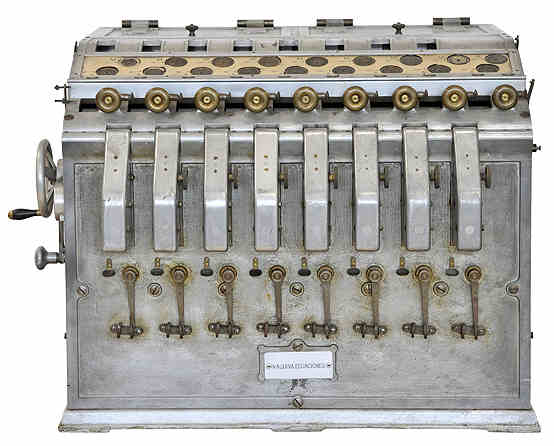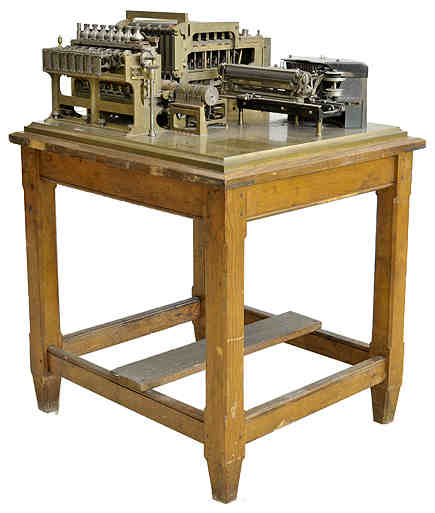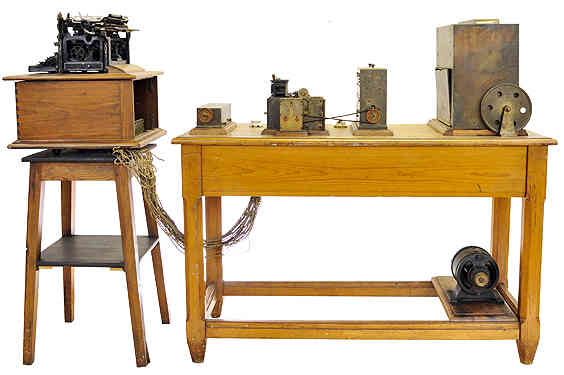
The Spanish engineer Leonardo Torres (y) Quevedo (1852–1936) had already attempted to solve difficult algebraic equations by mechanical means in 1893. He wanted to realize the dream of Charles Babbage. In 1912, he built the first chess-playing automaton, which he demonstrated in Paris in 1914. He designed an automatic electromechanical calculating machine, exhibited in Paris in 1920; it was coupled to a typewriter. Torres Quevedo was famous as a scholar, especially in Spain and France. In the German- and English-speaking countries, he has now been largely forgotten. He was far ahead of his time. His publications in Spanish are unfortunately not well-known.
His essays on automation (Ensayos sobre automatica, in: Revista de la real academia de ciencias exactas, fisicas y naturales, volume 12, 1913/14, pages 391–419), include a design for an automatic calculating machine (incorporating conditional instructions and fixed program control). In this treatise, he also considered floating point notation.
The Analog Calculating Machine of Torres Quevedo
In 1895, in an eight-part position paper, Torres Quevedo described his experimental algebraic machine, on which he had worked since 1893 (see Fig. 1). The machine was designed for the solution of arbitrary systems of higher degree algebraic equations.

This mechanical analog calculating machine made it possible to solve complex algebraic equations.
Credit: Museo Leonardo Torres Quevedo, Universidad politecnica de Madrid
The Analytical Engine of Torres Quevedo
In 1911, the many-sided inventor reported a new calculating system in the Revista de obras publicas. He introduced the electromechanical calculating machine in 1920 in Paris at the memorial exhibition for the Thomas arithmometer (100 years since the invention of the Thomas machine). The automaton (see Figs. 2 and 3) was designed for the four basic arithmetic operations and was connected by electric lines to a (physically separate) typewriter, which served for (remote-controlled) input and output. The program-controlled experimental model also was capable of executing certain conditional instructions. For automatic division, for example, of a five-place number, the divisor was compared with the remainder. According to whether the divisor was smaller or not, the machine continued differently.

The electromechanical arithmometer was capable of all four basic arithmetic operations.
Credit: Museo Leonardo Torres Quevedo, Universidad politecnica de Madrid

This experimental calculator was controlled from a typewriter, which served for input and output.
Credit: Museo Leonardo Torres Quevedo, Universidad politecnica de Madrid
Formal Language
In 1907, Torres Quevedo introduced a formal language for the description of mechanical drawings, and thus for mechanical devices, in Vienna (see Leonardo Torres Quevedo: Sobre un sistema de notaciones y simbolos destinados a facilitar la descripcion de las maquinas, in: Revista de obras publicas, volume 55, 1907, no. 1634, pages 25–30). According to the Austrian computer pioneer Heinz Zemanek, this was equivalent to a programming language for the numerical control of machine tools (see Heinz Zemanek: Central European prehistory of computing, in: Nicholas Constantine Metropolis; Jack Howlett; Gian-Carlo Rota (eds): A history of computing in the twentieth century, Academic Press, New York, London etc. 1980, page 599).
Wireless Remote Control
In 1903, Torres Quevedo introduced his Telekino (wireless remote control device), patented in the same year, at the Academy of Sciences in Paris.
In 1916, Torres Quevedo’s aerial cable car in Niagara Falls was completed.
References
Bruderer, Herbert: Meilensteine der Rechentechnik, De Gruyter Oldenbourg, Berlin/Boston, 3. Auflage 2020, Band 1, 970 Seiten, 577 Abbildungen, 114 Tabellen, https://www.degruyter.com/view/title/567028?rskey=xoRERF&result=7
Bruderer, Herbert: Meilensteine der Rechentechnik, De Gruyter Oldenbourg, Berlin/Boston, 3. Auflage 2020, Band 2, 1055 Seiten, 138 Abbildungen, 37 Tabellen, https://www.degruyter.com/view/title/567221?rskey=A8Y4Gb&result=4
Bruderer, Herbert: Milestones in Analog and Digital Computing, Springer Nature Switzerland AG, Cham, 3rd edition 2020, 2 volumes, 2113 pages, 715 illustrations, 151 tables, translated from the German by John McMinn, https://www.springer.com/de/book/9783030409739
Martin, Ernst: Die Schreibmaschine und ihre Entwicklungsgeschichte, Verlag Johannes Meyer Pappenheim, 1st edition 1925, pages 329–331
Saavedra, Eduardo: Informe interesante mencionado en el anterior resumen de actas sobre una maquina para resolver equaciones, in: Revista de obras publicas. Boletin, 1895, nos. 22–26, in 6 parts
Torres Quevedo, Leonardo: Arithmometre electromecanique, in: Bulletin de la societe d’encouragement pour l’industrie nationale, volume 119, September/October 1920, pages 588–599
Torres Quevedo, Leonardo: Electromechanical calculating machine, in: Brian Randell (editor): The origins of digital computers, Springer-Verlag, Berlin, Heidelberg etc., third edition 1982, pages 109–120
Torres Quevedo, Leonardo: Sobre un sistema de notaciones y simbolos destinados a facilitar la descripcion de las maquinas, in: Revista de obras publicas, volume 55, 1907, no. 1634, pages 25–30
Zemanek, Heinz: Eine formale Sprache aus dem Jahr 1907 von L. Torres y Quevedo, in: Elektronische Rechenanlagen, volume 10, 1968, no. 1, pages 5–6
Herbert Bruderer (herbert.bruderer@bluewin.ch; bruderer@retired.ethz.ch) is a retired lecturer in the Department of Computer Science at ETH Zurich and a historian of technology.



Join the Discussion (0)
Become a Member or Sign In to Post a Comment